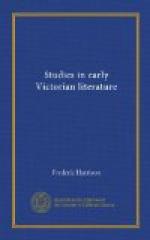But Jane Eyre’s ignorances and simplicities, the improbabilities of her men, the violence of the plot, the weird romance about her own life, are all made acceptable to us by being shown to us only through the secret visions of a passionate and romantic girl. As the autobiography of a brave and original woman, who bares to us her whole heart without reserve and without fear, Jane Eyre stands forth as a great book of the nineteenth century. It stands just in the middle of the century, when men were still under the spell of Byron, Shelley, Coleridge, and Wordsworth, and yet it is not wholly alien to the methods of our latest realists.
It is true that a purely subjective work in prose romance, an autobiographic revelation of a sensitive heart, is not the highest and certainly not the widest art. Scott and Thackeray—even Jane Austen and Maria Edgeworth—paint the world, or part of the world, as it is, crowded with men and women of various characters. Charlotte Bronte painted not the world, hardly a corner of the world, but the very soul of one proud and loving girl. That is enough: we need ask no more. It was done with consummate power. We feel that we know her life, from ill-used childhood to her proud matronhood; we know her home, her school, her professional duties, her loves and hates, her agonies and her joys, with that intense familiarity and certainty of vision with which our own personal memories are graven on our brain. With all its faults, its narrowness of range, its occasional extravagances, Jane Eyre will long be remembered as one of the most creative influences of the Victorian literature, one of the most poetic pieces of English romance, and among the most vivid masterpieces in the rare order of literary “Confessions.”
VIII
CHARLES KINGSLEY




